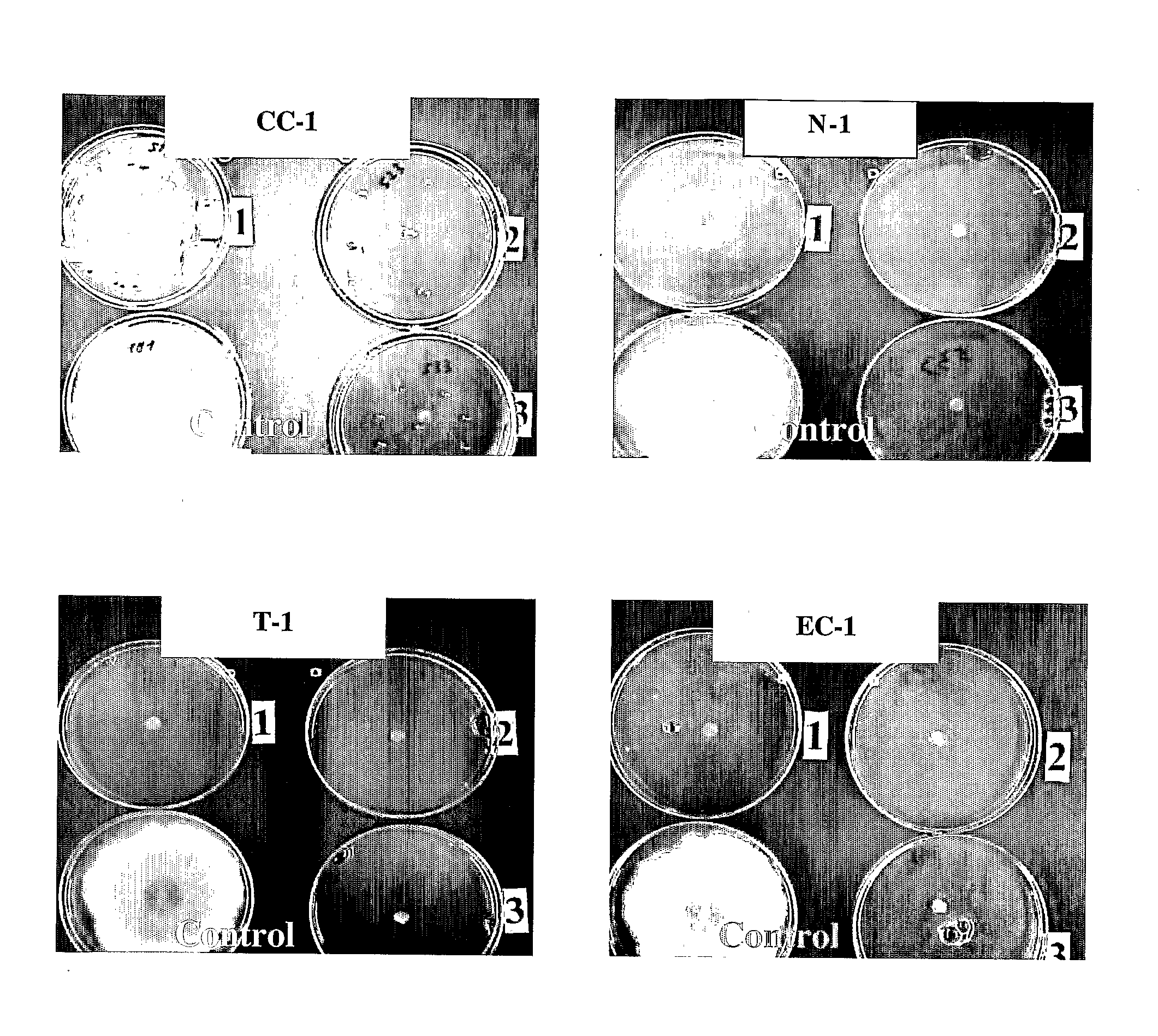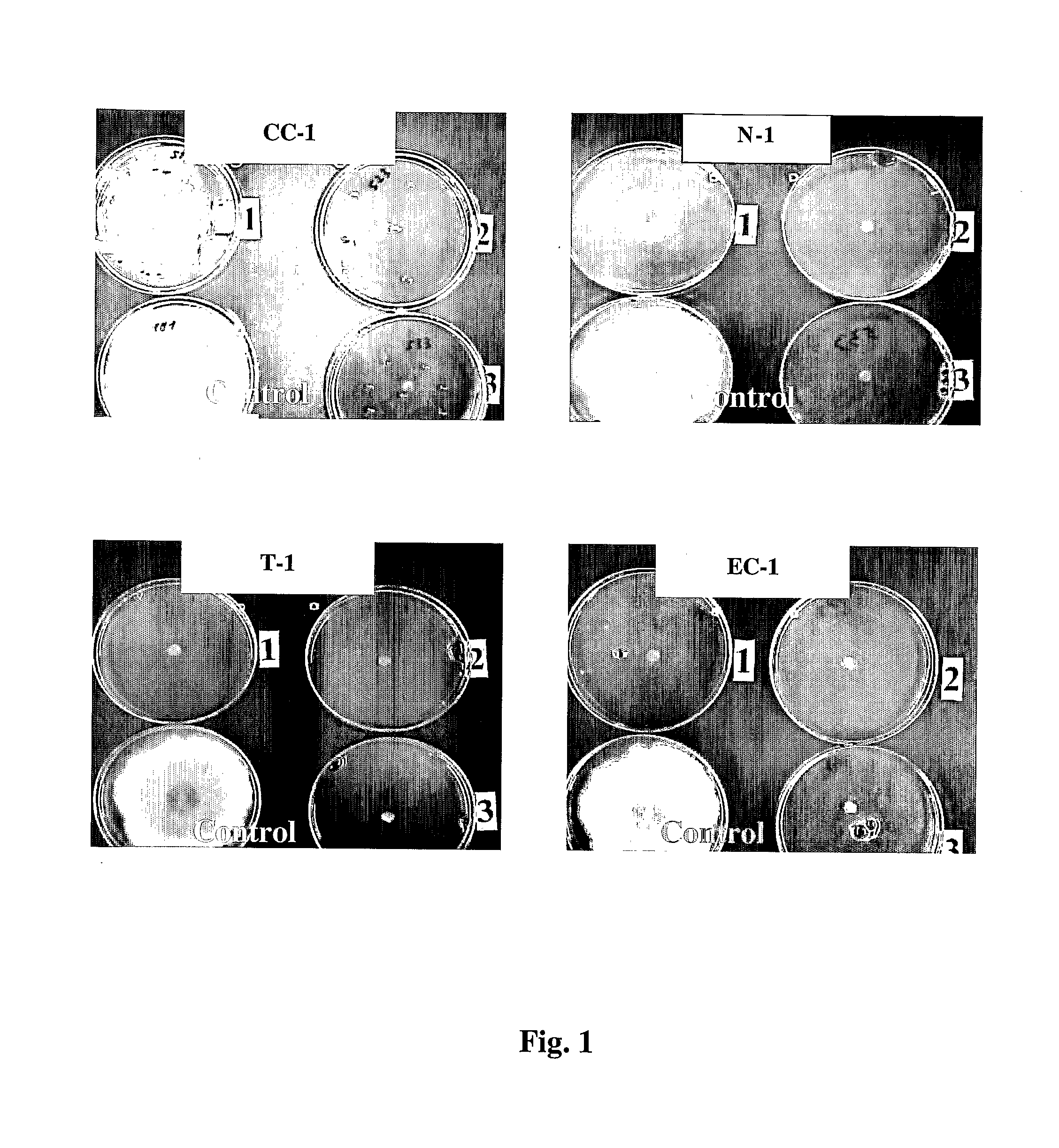Compositions and Methods for Protection of Harvested Fruits from Decay
a technology for preserving and preserving fruits, applied in the direction of biocide, plant growth regulators, plant ingredients, etc., can solve the problems of affecting the quality of fruits
- Summary
- Abstract
- Description
- Claims
- Application Information
AI Technical Summary
Problems solved by technology
Method used
Image
Examples
example 1
In Vitro Screening of Essential Oils
[0087]Screening of essential oils and individual components thereof was carried out in order to evaluate their in vitro activity in inhibiting the growth of the pathogenic fungi. The isolated plant pathogenic fungi: Botrytis cinerea, Rhizopus stolonifer, Alternaria alternata, Penicillium digitatum and Penicillium italicum, were grown on Petri dishes in the presence of different concentrations of the essential oils. As shown in FIG. 1, Cinnamon cassia oil (CC-1), Nutmeg oil (N-1), Thyme oil (T-1) and Eucalyptus citriodora (EC-1) oil at different concentrations: 1. 71.4 ppm; 2. 357 ppm; and 3. 714 ppm, significantly inhibited the growth of Botrytis cinerea in comparison with control (untreated Petri dish). The concentration in ppm is defined herein as the volume in μl of essential oil loaded on the filter paper per volume of the Petri dish in liters (μl / L).
[0088]Tables 1-5 summarize the percentage of inhibition of growth of various fungi in vitro by...
example 2
Low Doses of Mustard Essential Oil or Cinnamon Cassia Oil Significantly Reduce Black Spot Disease Caused by Alternaria alternata in Persimmons
[0090]Persimmons (10 replicates of 10 fruits per container) inoculated with Alternaria alternata (four infection sites inoculated with 10 μl suspension, 106 spores / ml, on each fruit), were incubated with Mustard essential oil (4 ppm) or Cinnamon cassia oil (20 ppm) for 3 hours in sealed containers, and thereafter stored in the same slightly opened containers for up to 39 days at 20° C. Inoculated persimmons not treated with the essential oils were used as control.
[0091]As shown in FIG. 2A, Cinnamon cassia oil (20 ppm) and Mustard essential oil (4 ppm) reduced the Alternaria alternata rot on persimmons by 80% and 100%, respectively, during 39 days storage at 20° C. The significant inhibitory effect of Mustard oil (M-1) on the development of decay in persimmons inoculated with Alternaria alternata and stored at 20° C. for 33 days, is shown in FI...
example 3
Low Doses of Mustard Essential Oil, Nutmeg Oil or Cinnamon Cassia Oil Significantly Reduce Decay Caused by Grey Mould (Botrytis cinerea) in Strawberries
[0092]Strawberries (10 replicates of 10 fruits per container) were inoculated with Botrytis cinerea (106 spores / ml), incubated in sealed containers with Mustard essential oil (1-4 ppm), Nutmeg oil (1-10 ppm) or Cinnamon cassia oil (1-20 ppm) for 3 hours and stored in the same slightly opened containers for up to 34 days at 4° C. or for up to 7 days at 20° C. Inoculated strawberries not treated with the essential oils were used as control.
[0093]As shown in FIG. 3A, Botrytis cinerea decay on strawberries was suppressed by 40% following incubation with a low dose of Nutmeg oil (10 ppm) (4° C., 28 days). Significantly reduced decay was also achieved by applying a low dose of Mustard essential oil (4 ppm) (4° C., 31 days). The effect of Cinnamon cassia oil at two different concentrations (10 ppm and 20 ppm) on inhibition of decay developm...
PUM
 Login to View More
Login to View More Abstract
Description
Claims
Application Information
 Login to View More
Login to View More - R&D
- Intellectual Property
- Life Sciences
- Materials
- Tech Scout
- Unparalleled Data Quality
- Higher Quality Content
- 60% Fewer Hallucinations
Browse by: Latest US Patents, China's latest patents, Technical Efficacy Thesaurus, Application Domain, Technology Topic, Popular Technical Reports.
© 2025 PatSnap. All rights reserved.Legal|Privacy policy|Modern Slavery Act Transparency Statement|Sitemap|About US| Contact US: help@patsnap.com



